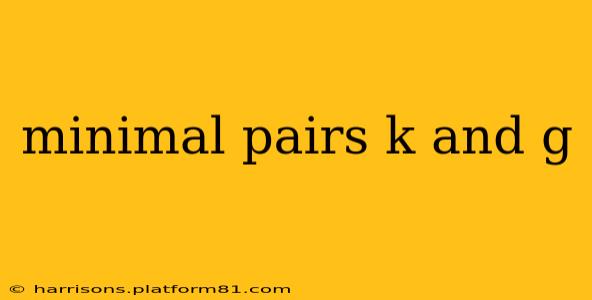Minimal pairs are words that differ by only one phoneme, highlighting the contrast between sounds. This article focuses on the minimal pairs featuring the sounds /k/ and /g/, crucial for English pronunciation and comprehension. Mastering these distinctions will significantly improve your fluency and clarity.
What are Minimal Pairs?
Before diving into the specifics of /k/ and /g/, let's define minimal pairs. They are pairs of words that:
- Differ in only one sound: This single sound change alters the meaning of the word.
- Are otherwise identical: The other sounds and the word's structure remain consistent.
Understanding minimal pairs is key to improving pronunciation and distinguishing between similar-sounding words.
Minimal Pairs for /k/ and /g/
The sounds /k/ and /g/ are both voiceless and voiced velar stops, respectively. This means they are produced by stopping airflow at the back of the mouth (velar). The key difference lies in voicing: /k/ is voiceless (vocal cords don't vibrate), while /g/ is voiced (vocal cords vibrate). This subtle difference creates a significant impact on word meaning. Here are some examples of minimal pairs illustrating this distinction:
Key Minimal Pairs:
- Cat / Gat: While "gat" isn't a standard English word, it highlights the phonetic difference perfectly. The presence of voicing in /g/ drastically alters the meaning.
- Cool / Gool: Similar to the previous example, "gool" is not a common word, but it effectively demonstrates the minimal pair concept.
- Cake / Gage: This pair shows the difference within a more standard vocabulary context.
- Back / Bag: This is a common and easily understood example, highlighting the difference in the initial sound.
- Kick / Gig: This pair demonstrates the difference in the middle of a word.
- Lake / Lage: Similar to 'cake/gage', this pair shows the /k/-/g/ contrast in a different word structure.
More Challenging Minimal Pairs:
Some minimal pairs are more difficult to distinguish, particularly for non-native speakers. These often involve words with additional sounds that can mask the /k/ and /g/ distinction. Careful listening and practice are essential here. Examples include:
- Coat / Goat: The vowel sound can sometimes overshadow the initial consonant difference.
- Cue / Glue: Again, the vowel sound plays a significant role, making this a slightly trickier distinction.
Why are Minimal Pairs Important?
Understanding and practicing minimal pairs offers several significant advantages:
- Improved Pronunciation: Regularly working with minimal pairs hones your ability to produce the /k/ and /g/ sounds accurately, leading to clearer speech.
- Enhanced Listening Comprehension: Recognizing the subtle differences between these sounds improves your ability to understand spoken English.
- Increased Fluency: Accurate pronunciation and comprehension contribute directly to improved fluency.
How to Practice Minimal Pairs
Effective practice involves actively engaging with the sounds. Here are some suggestions:
- Listen and Repeat: Repeatedly listen to and try to imitate the pronunciation of the minimal pairs. Pay close attention to the subtle difference in voicing.
- Record Yourself: Recording your pronunciation helps you identify areas needing improvement and track your progress.
- Use in Sentences: Integrate the minimal pairs into sentences to practice them in a more natural context. This helps with flow and overall spoken communication.
Conclusion
Mastering the minimal pairs for /k/ and /g/ is crucial for anyone striving for accurate and fluent English pronunciation. By consistently practicing these pairs, you can enhance both your speaking and listening skills, leading to significant improvements in your overall English proficiency. Remember, consistent effort and mindful practice are key to success.
